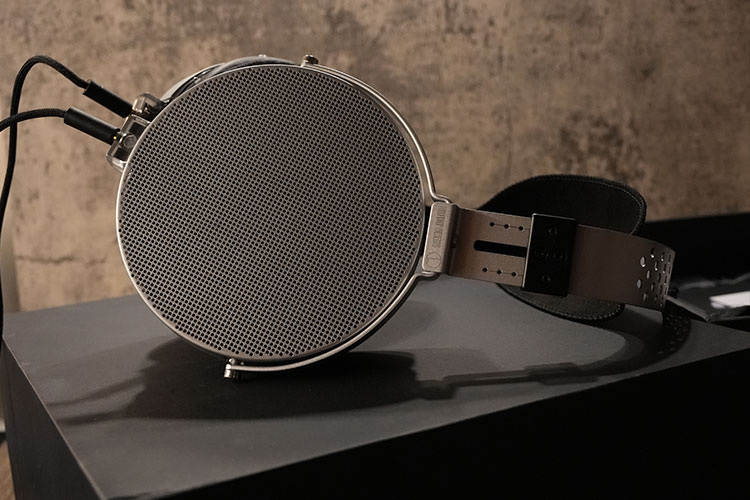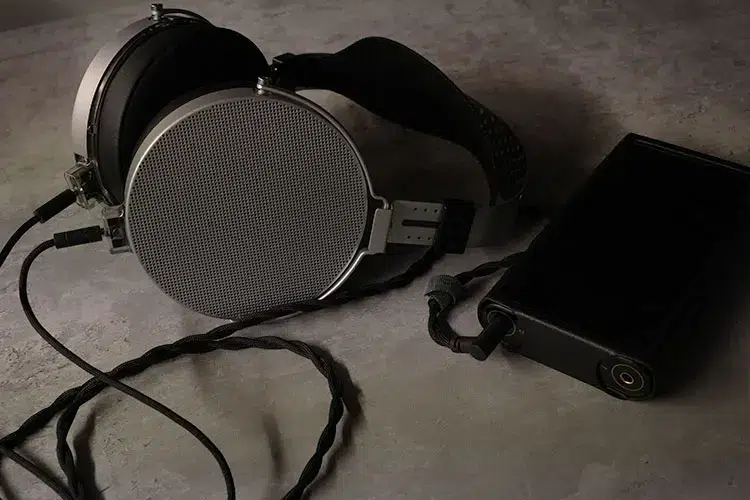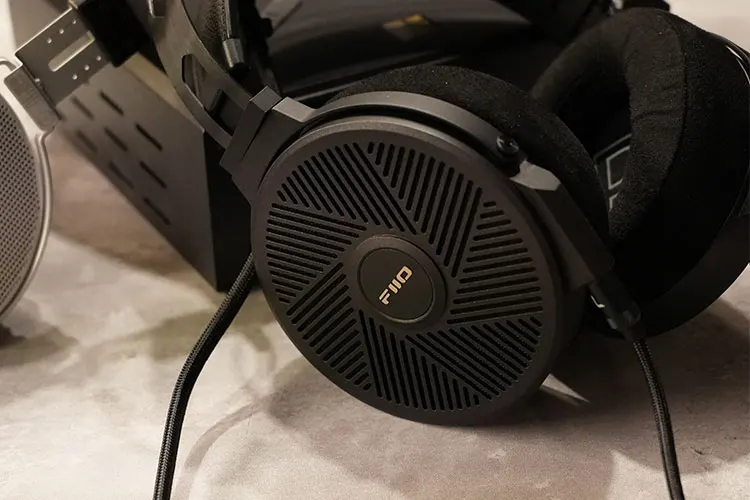Synergy
Efficiency
The PARA has a sensitivity rating of 101dB/Vrms at 1kHz and an impedance of 8Ω. This indicates that it is relatively sensitive and can be driven to loud volumes with ease.
However, to fully unleash its potential and achieve optimal performance, it benefits from a good current supply.
You may hear it picking up faint hisses from the source due to its sensitivity but with low to mid gain on the source it is unlikely any sibilance will disturb the listening experience.
Pairings
While testing the PARA headphones with different gear, including the Shanling M9 Plus, I was pleasantly surprised by the level of control and smoothness in the sound delivery.
The transition from the midrange to the treble was seamless, with good control and tonal balance. The overall presentation leaned towards neutrality, making it a versatile choice for various music genres, particularly instrumentals that benefited from the PARA’s dynamic range and the lifted air.
When switching to the 4.4mm balanced cable, specifically the one provided with the Venus, the PARA exhibits a noticeable improvement in the soundstage. The sound opens up more and expands horizontally, creating a more immersive listening experience, and there is a stronger sense of realism with the protruded treble.
When paired with the FiiO K9 Pro ESS, the PARA maintains a rather neutral and natural sound signature without any harsh spikes.
The sound reproduction remains balanced, allowing for an accurate representation of the audio across the frequency spectrum. Additionally, the PARA delivers strong dynamics, adding a sense of impact and excitement to the listening experience.
With my current setup on the xDuoo XD05 Pro, the output is clean and fast. While vocal reproduction may have a slightly raw quality, there is good density and weight. I am expecting the upcoming modules for the XD05 Pro to further polish the midrange and perhaps strengthen the current output capabilities.
With less powerful devices, such as the L&P W2 dongle, I am surprised to find that the output still sounds fairly detailed and balanced. It is still recommended to at least pair the PARA with a small desktop amplifier or powerful DAP that has a clean output and ideally current amping, to realize its true potential.
Select Comparisons
MOONDROP Venus
Technical
The Venus is the first planar model from MOONDROP with a 100mm driver at 2 microns thickness and 1μm of silver deposited on the circuit.
PARA seems to share quite some of these traits such as using a 100mm diameter driver, and both designs also use the Finite element analysis (FEA) technology for examining how the material design affects the technical performance.
The impedance of the Venus is rated at 18Ω at 1kHz, while its sensitivity is rated at 100dB/Vrms. This makes it comparatively less sensitive than the PARA headphones, which have an impedance of 8 ohms and a sensitivity rating of 101dB/Vrms.
Design
There are several similarities between the Venus and the PARA headphones, and it’s evident that several improvements have been made to the framework. The raw metallic design and cooler faceplate on the Venus, along with the self-adjusting headband adjustment, present a cleaner aesthetic.
However, it lacks a locked mechanism, which can cause the ear cups to fall out from the frame under pressure.
In contrast, the PARA addresses this issue and ensures that all parts are securely attached to the frame. The headband adjustment has been changed to be user-adjustable, allowing for an even easier and more precise fit when putting the headphones on and taking them off.
Performance
While the two headphones have a similar outlook and exhibit some similar character in the way the treble rides on the mid-lows to enhance vocal clarity, there is an audible difference in how they respond to power as well as the way they present different elements.
When comparing the headphones at higher volume levels, both the VENUS and PARA demonstrate a distortion-free performance.
However, the VENUS stands out with its stronger intensity and depth in bass delivery. It exhibits a more pronounced layering effect, creating a sense of depth and separation in the soundstage. The PARA takes a slightly more conservative approach but still maintains a playful presentation.
The PARA exhibits a slightly more forward midrange presentation with added body, which enhances the richness of vocals.
The VENUS takes a more comprehensive and neutral approach, allowing for a better overall view of the broader musical picture rather than focusing solely on vocals. This neutrality provides a wider perspective on the entire sound spectrum.
The VENUS headphone exhibits a stronger intensity in the mid-treble range, followed by small bumps in the sibilance zone, resulting in an exciting sparkle in the sound. Whereas the PARA takes a more conservative approach in the treble range, delivering a smoother presentation.
This allows for more subtle details in the harmonics to be revealed, making it particularly well-suited for skilled vocalists, chamber music, older tunes from the 70s, and synthesized instruments that have a colorful tonality within that specific frequency range.
I find it easier to achieve an enjoyable output with the PARA headphones which have a more natural presentation. Whereas the VENUS headphones may sound restrained when used with low-power sources, it does have stronger technicalities when sufficiently powered.
FiiO FT5
Technical
The Fiio FT5 headphones utilize a planar magnetic driver design that employs a similar approach to cover the entire diaphragm in the magnetic field.
This design aims to achieve enhanced uniform motion compared to dynamic drivers, which typically have single-point movement. Placing the entire diaphragm in the effective area of the magnetic field ensures synchronous movement across different areas of the diaphragm, eliminating time differences.
The FT5 has an impedance rating of 36Ω and a sensitivity of 110dB/1Vrms at 1kHz. This indicates that the FT5 will respond to power differently compared to the PARA headphones, which have a much lower impedance rating.
The FT5 may be able to withstand and scale its performance with stronger voltage swings or gain, potentially enhancing its dynamics and for the PARA it will be more easily driven well by less powerful sources.
Design
The FiiO FT5 exhibits a robust design and incorporates the brand’s distinctive sci-fi design language, while the PARA’s design, derived from sheet metal, offers a cool aesthetic.
On the other hand, the FT5 comes with XLR converters and swappable 3.5mm/4.4mm termination on the cable, which makes it more versatile for different usage scenarios.
In practice, the hinge on the FT5 moves smoother and the design is overall more industrial, with more accessories bundled with the package as well including a leather case and XLR plugs.
Performance
At a similar price point, both headphones exhibit impressive qualities that highlight the strengths of planar magnetic designs. They excel in areas such as transient response, fast response, and overall accuracy.
The PARA is designed with a focus on the upper frequencies and harmonics, resulting in an open and joyful sound signature that emphasizes vocal delivery.
The FT5 places more emphasis on bass and layering, creating a more expressive sound profile that complements darker voices.
Regarding technical performance, the more V-shaped sounding FT5 holds a slight advantage in retrieving nuances, especially when properly driven. Its stronger technical capabilities enable finer details and subtle elements within the music to be more easily discerned, thereby enhancing the overall listening experience.
It is noteworthy that the FT5 has a higher impedance and can benefit from stronger amping and with most pairing it has a more laid-back, smooth tuning compared to the PARA that lets the vocal line cut through with more power.
In contrast, the PARA that has lower impedance ratings offers easier pairing, achieving a balanced sounding output even when put with mid-end DAPs, and it excels at making the mid-range sound distinct and cleanly separated.
This quality contributes to improved clarity and separation of vocals and instruments within the mid-range frequencies.
It is also fun to note that both products come with a different set of earpads and the change is very noticeable upon switching. It is highly recommended to experience how the pads alter the sound signature making it more favorable depending on your age, music, and sound signature preference.
Our Verdict
The MOONDROP PARA is a flexible set of planar headphones with impressive tuning.
It can deliver a smooth and vivid sound on various portable devices while offering room for improvement with better decoding and amplification to achieve a more resolving and dynamic performance. It strikes a better balance in tone compared to the Venus, which is not as controlled in the treble.
The performance remains steady and distortion-free even at higher volume levels which is a big plus, and I do wish that it came with a 4.4mm cable and a converter as standard, also that the design could be slightly more innovative.
Overall, the PARA offers excellent value with its engaging sound and impressive technicalities, truly raising the bar within its competitive landscape.
MOONDROP PARA Technical Specifications
- Sensitivity: 101dB/Vrms(@1kHz)
- Impedance: 8Ω±15%(@1kHz)
- Termination: 3.5mm (stock cable)
- Frequency response: 20-20kHz (IEC60318-4, -3dB)





